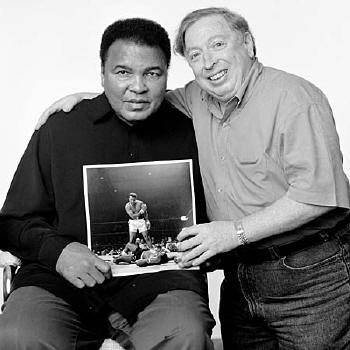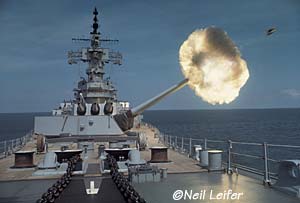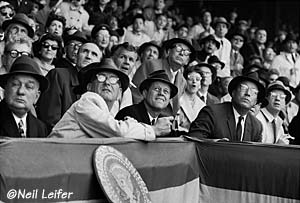Chris/Larry: Your images have been on the cover
of more than 200
issues of Sports Illustrated and Time Magazine. How does one begin such an
illustrious career?
Neil: I started taking pictures as a kid around 1954 or 1955, I grew up
on the Lower East Side of Manhattan where I belonged to the Henry Street
Settlement. They had a photo workshop that was run by a wonderful woman
named Nelly Peissachowitz, who really had that ability that good teachers have to
excite young people. Her influence sure worked with me and was a major
factor in
my choice of making a career out of photography.
Chris/Larry: What kind of subjects did you shoot?
Were you always attracted to shooting sports?
Neil: I wasnít immediately attracted to
photographing sports. I was more interested in photographing Navy ships
and Air Force and Navy planes. I used to cut school to photograph aircraft carriers
and battleships coming in and out of the Brooklyn Navy Yard which was
across the East River from where I lived. I wanted to be a Navy pilot when
I grew up. I took the subway and a bus out to Floyd Bennett Field which
was out to the boondocks
of Brooklyn to photograph Navy planes from the highway, as theyíd come in and
out for landings and takeoffs. That was my first real passion. When I got to high school I became the picture editor for
the school newspaper. My staff photographer was Johnny Iacono,
who was also my best friend. Johnny is
now and has been for years a staff photographer at Sports Illustrated. I
started photographing sports more in high school for the school
newspaper. I really enjoyed taking pictures and Ioved seeing my name on
the credit line when they were published. As a kid I didnít have any money and it seemed an
easy way to get into a sporting event was with a credential. The problem
was that I was fifteen years old and I didnít have any credentials.
Chris/Larry: So how did you work around that
little problem?
Neil: I discovered early in the 1958 pro football season that
every Sunday a veteranís hospital would come with three or four bus
loads of army vets, most of whom were in wheel chairs to see the New York
Giants play football at Yankee
Stadium. Since they never had enough people to help wheel them in, I would
wait for the busses to come and volunteer to help, soon becoming a
regular. I was now able to watch every game from along the outfield wall
where the monuments were, we were actually on the field just behind the outfield
end zone. When it got cold late in the season, I would bring a cup of
coffee to the security guards on the sidelines and they would look the
other way when I took out my Yashica Mat, the poor manís Rolliflex, and
shot a few pictures.
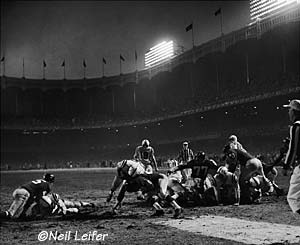
There is a picture in my book ďThe Best of LeiferĒ
of Alan Ameche scoring the winning touchdown in what has been
referred to as "the greatest game ever played". It was the
famous sudden death between the Baltimore Colts and the New York
Giants, which coincidentally took place on my 16th birthday, December
28th 1958. When Alan Ameche scored the winning touchdown there were
so many Coltís fans, (mainly drunken Coltís fans) on the field that the
security had their hands full just making sure that they could keep those people
off the field. They werenít worried about someone like me that they had
seen every week. So I ended up exactly ten yards in front of Ameche as he
scored the winning touchdown. He came right at me and I got that picture, which today, is
certainly one of my best-known pictures. I always think that if I had had
any money and any decent equipment, I would never have taken that picture
because, if I would have had a long
lens, a 135mm or a 180mm, I would have tried to fill the frame with Ameche
going in for the winning touchdown. Instead I got the wide shot that
takes in the whole ambiance of Yankee Stadium that afternoon which is so
much better than any picture I would have taken years later when I was an
established pro.
Chris/Larry: So even back then you were able to be
in the right place to capture the moment that defined the game.
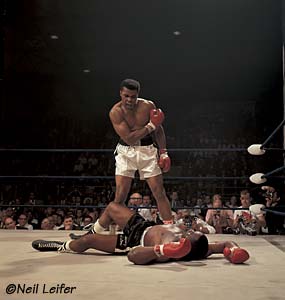
Neil: Well, I was lucky. I donít want to sound
like Iím just being modest about it. Most good photographers I know,
sports or any other kind, have pretty healthy egos and Iím certainly no
exception to that. But sports photography is a matter of being in the
right place. Youíve got to be in the right seat. A great example is to
the Liston Ali picture. The photographer you see between Aliís legs is
Herbie Scharfman, the other Sports Illustrated photographer. It
didnít make a difference how good he was that night. He
was obviously in the wrong seat. What the good sports photographer does is when it happens and
youíre in the right place, you donít miss. Whether thatís
instinctual or whether itís just luck, I don't know.
Chris/Larry: A matter of a lot of practice and
training perhaps?
Neil: I just think itís how you view things. If you think of it
as any other kind of photography, basically when the elements are all
there in front of you, how you compose the frame, what lens you chose, how
you chose to shoot it in terms of shutter speed, etc, etc.
Chris/Larry: Throughout your entire career
youíve been able to capture an entire story in a single moment, to portray
the entire event with a single image. How do you tune in to that? Are you
dispassionate when youíre observing the game, are you totally involved?
How do you really know the pulse of the game, or the pulse of the event,
whatever youíre photographing? How do you see the big picture?
Neil: You donít as itís happening. The picture that you shoot in the first quarter
that seems so very significant, quickly becomes meaningless if the game
goes another way in the second quarter. My Mohammed Ali Sonny Liston picture
wasnít even published on the cover of the magazine when it happened, so it
wasnít considered such a great picture when I took it. For whatever reason it grew in
popularity as Aliís reputation and stature and legend grew. I think that with sports pictures the objective is pretty
simple. Weíre still journalists, shooting for a newsmagazine like Sports
Illustrated or Time or Newsweek. Youíre there to shoot the star of the
game, in the play that won or lost the game, hopefully in a memorable picture. And you
can't know when that picture is going to happen. Someone once asked me why so much of sports
photography is done with sequence cameras. The inference being that it
lessens the photographerís skill, if you can shoot five frames a second.
Youíre shooting a sequence of the winning touchdown at five frames a
second and one says ďbut how can you miss at five frames a second?Ē
Here's how: Let's say, for example that the ball is on the one foot
line and the fullback leaps up over the line and heís eight feet in the
air, whatever. You get this magnificent moment. That is the picture,
right? Well not necessarily because let's say that
immediately after you snap that picture, assuming youíre shooting one
frame, he fumbles. That picture no longer mattered that was so perfect a
tenth of a second ago. Itís now the ball sailing out of his arms and eight
guys trying to recover it. Five frames a second and youíre still on that
play and you may have the picture that runs as the cover of the magazine.
The opening spread may very well be the picture that happened ten frames
after what at one moment looked like the best picture you could imagine.
Chris/Larry: Just donít run out of film first.
Neil: (laughs) Well thatís an important part of the job for
sure.
Chris/Larry: Can you tell us about any specific
images that influenced you when you were first starting out? Perhaps other
photographers and the things they did that really made an impression that
guided you along the way?
Neil: For starters I was a huge credit
reader. I looked at Life Magazine every week, I looked at Look Magazine
every two weeks, and I began looking at Sports Illustrated when I got keen
on sports photography. All my heroes were the photographers that I hoped
to someday be as good as. Hy Peskin,
Marvin Newman, John Zimmerman, George Silk,
Mark Kaufman. They were really my five heroes. Each one of
them had something that was a bit different. I liked the versatility of a
Mark Kaufman who not only could shoot wonderful action pictures but could
shoot a very sensitive portrait in the studio. I always wanted to know how
to light something as well as Mark did. Mark was one of the original staff
photographers at Sports Illustrated. He also was the first photographer to
do the Life cookbooks. He could do still lifes of food, which to this day
I wouldnít begin to know how to do. I loved the action pictures that Hy
Peskin took. His great boxing pictures in particular still knock me out. And John Zimmerman was someone who could do everything
almost as well as Mark and was even better with action pictures. Marvin Newman was just an all around great sports
photographer. George Silk was more of an artist, more
creative, doing more artsy kind of stuff, but always taking memorable
pictures.
Chris/Larry: Your new book, ďThe Best of LeiferĒ
has a remarkable range of pictures in it. And yet thereís cohesiveness.
Can you describe the common thread, things you absorb from other
photographers. How you interpreted it and how it created in you the
ability to create that body of work?
Neil: Mark Kaufman told me years ago when I was
still a kid, that he thought that being a sports photographer was the best
training ground to do anything in photography. Whether itís a political convention or
election eve, or the Pope coming to America, or war coverage, in terms of
the discipline it was a perfect training ground for everything else. The
techniques that I learned in sports photography were put to terrific use
when I moved over to Time Magazine in 1978. One of the great editors of all times, Ray Cave, had been
executive editor at Sports Illustrated before he became managing editor at
Time Magazine. He offered me the opportunity to move over to Time, which
gave me a whole world to explore rather than just sports, something which I always
wanted to do. Iím very, very proud of my sports pictures. But, you get
pigeon holed. You do something well and suddenly nobody thinks of you as
being able to do anything else. The example Iíve use many times is if an
editor
wanted to shoot Mohammed Ali in black tie against a white background in a
studio, itís get Neil Leifer. But if you want Sidney Poitnier or Denzil Washington, or Will Smith in black tie in a studio,
that editor wouldnít think of assigning me. It's almost as though editors
think I can only speak to and photograph athletes. In fact, either you
know how to shoot a portrait in a studio and make it come alive or you
don't. It isnít like athletes are speaking a different language. Moving to
Time Magazine gave me that opportunity to explore other things. And I used
the very techniques that I had used in sports over and over again. Anybody shooting
sports has to be very adept with long lenses. I probably used a 600 more than any
other lens. So using long lenses to shoot animals for an essay for Time Magazine
was of course, piece of cake for me. The remote cameras that I used in so many sports
pictures, whether itís under the rail of the Kentucky Derby, over the ring
at a boxing match, or just as an extra camera to get the double play at
second base. I was able to put it to use in many other ways for non-sports
pictures. I mounted one over the cellblock in my prison essay, which was
in fact the cover of the magazine. I put a camera right up over the middle
of the cell. Itís no different than my picture of Cleveland Williams and
Mohammed Ali except that this time it was in a prison cell. I hung a
camera from the portal of the bow of the USS Carl Vincent and pointed it
back and shot F14ís coming off the side catapult. No different from any
number of sports remote pictures Iíve done. The skills that you picked up
in sports I just put to use on other assignments.
Chris/Larry: Out of the amazing range of things
youíve shot, you must have your favorites. When you look back, which
pictures are you really proud of?
Neil: The pictures in my book are my
favorite pictures but for different reasons. For example, the picture of Yogi Berra being
picked off second base in the World Series in 1960 happened to be the first full color
page I had
in the magazine. The competition that day was Hy Peskin, Marvin Newman and
John Zimmerman. It was the first time I realized that perhaps I can
compete with these guys. And the picture of YA Title dropping back to pass
was my first Sports
Illustrated cover. So my favorite pictures are not really necessarily my
best ones. Theyíre pictures that bring back memories. Theyíre certain
moments in my career that were very special.
Chris/Larry: It's actually quite a different
question to say what are your favorites verses what do you feel are your
best photographs.
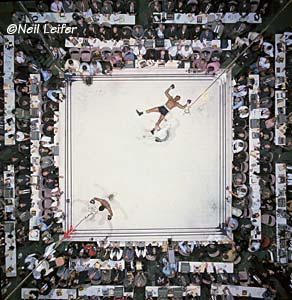
Neil: I know, and my best picture ever, in my opinion, is my Ali Cleveland
Williams picture that I shot from overhead. I donít usually hang my own photos, I
collect other peopleís pictures. But that pictureís been hanging in my
living room as long as I can remember. I have a 40x40 print of it
which is hung in a diamond shape with Williams at the top. That's the guy
thatís on the canvas on his back.
Chris/Larry: Itís remarkably abstract for a sports
picture.
Neil: I
think itís the only picture in my career that thereís nothing I would do
different with it. You look at pictures and think
that you can always improve them no
matter how successful the shoot is. Part of what motivates you to go on to
the next shoot is every once in a while you get a picture, whether it's
the cover of the
magazine or an inside spread, that's as good as you think you
could have made it. And then a week later you see a couple of things that
you could improve slightly. A month later you
might see
a few more things. It doesnít diminish the quality of that picture. It
simply means that there's always room for improvement.
Chris/Larry: Youíre learning for the future?
Neil: Exactly. Itís sort of what motivates you to
go on. If I were to do the Cleveland Williams Ali picture again, I
would do it exactly the same. And more important is that no one will ever do it
better because it canít be done like that anymore. Today the ring is
different and the fighters dress in multi colored outfits like wrestlers.
Back then the champ wore white and the challenger wore black. Today,
when you look down at
the ring from above, you see the Budweiser Beer logo in the center and around
it is the network logo thatís televising the fight. Whether itís Showtime or
HBO, they have their logo two or three times on the canvas. The logo of promoter
of the fight, Don King Presents, is also visible. That's why that picture
couldn't be taken today. So not only did the picture work out better than any Iíve ever
taken, but itís one thatíll never be taken again.
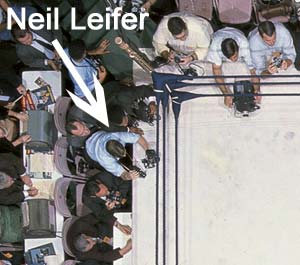
Chris/Larry: Where are you in this picture?
Neil: Iím at 11:00 oíclock, as I remember it. Iím in a blue
shirt leaning on the canvas with a camera in each hand.
Chris/Larry: You were always really creative working with
remote set-ups. How did your editors react to those unique views? Did they encourage you to keep pushing limits and putting cameras
in unique places?
Neil: Yes. They were very excited when it worked. Over the
years, some of my best photos were ones taken by remote. I really followed
in the footsteps of John Zimmerman, who did remote shots better than anyone else. Hy Peskin did a lot of it
also so I wasnít the first person by any
stretch. Photographers have been mounting cameras over boxing rings for years. That picture
of Ali Williams was simply done differently and that was something I
figured out and capitalized on it. I got more fun out of watching
the next fight at the Houston Astrodome when there were eight people
fighting to get the center spot on the overhead grid that I had used. Most
of the time, the ring lights at a fight were about 20 feet up and
supported by poles in each corner of the ring so there was no way to shoot down and get the whole ring in unless you
used a fisheye which distorted the view. You donít get
anybodyís face, just the top of the heads. Something different
than what I wanted. Or you didnít get the full ring in and certainly not
enough of the fans. So most remote pictures of boxing are done with the
camera in the corner of the ring looking out so that hopefully you get one
guy on the canvas and see just a little bit of the face of the person who
scored the knockdown. This was going to be the first fight in the Houston
Astrodome. In order to get
the sight lines clean from the upper decks the lights were going to be 80
feet over the ring. When I realized that, I realized that for the first
time you could put a lens up there, get in the entire ring and get in some
of the seats. But the widest Hasselblad lens at that time was the 50mm. Today I
would have put a 40 or a 30 on it and gotten even more in the picture. The fact was that
for the first time you could put a camera up there and get that kind of an
effect and that I figured out. It immediately struck me that
it would make a good picture. I never anticipating that nice knock out. But
you know, if I hadnít have gotten it at that fight I might have gotten it
at the next fight at the Astrodome.
Chris/Larry: Thereís an early shot of you in the
beginning of the book, youíre basically still a kid, I think it was 1961.
You had the three Nikon cameras around your neck, I noticed that you had a
lot of long lenses on there that did not appear to be Nikon. At the time,
Nikon had a fairly limited repertoire of long lenses. You seemed to be
real creative with having things made to order or adapted to the equipment
you need.
Neil: Sports Illustrated helped me out. At that
point I was already using professional equipment. Iíve got motor driven
Nikons. Nikon did not make a 400. Thatís a 400mm Kilfitt in the picture
and all the other lenses are Nikon. That zoom there was Nikon's first zoom.
I think it was an 80 to 250 or something, I donít remember. And even
compared to the Nikon 300, the Kilfitt lenses were better lenses at the
time. So most pros were using Kilfitt lenses with a Nikon adapter, and it
was very common. In terms of shooting night football and night sports,
probably the best lens thatís ever been made is the 300mm f2.8. A company
called Topcon made a 300mm f2.8 about five years before Nikon did, and for
years Marty Forscher made Topcon to Nikon adapters that
every sports photographer owned. It was a basic lens, the 300mm 2.8.
Chris/Larry: Were these presets?
Neil: They didnít close down on their own. But you
bought a 300mm f2.8 to shoot at 2.8 so you werenít a whole lot concerned.
The Kilfitt lenses were German lenses and were very good. In fact I bought
Mark Kaufmanís 150mm Kilfitt when I began shooting at Sports Illustrated.
Chris/Larry: Of course today people expect cameras
to be auto focus and to have auto exposure.
Neil: They didnít have auto anything then. Nikon didn't even
make remotes for their cameras back then. But Marty Forscher made remotes for them. Al Schneider who
ran the Life studio was also sort of the technical whiz who built things for the great Life Magazine essays. Today you can go out and buy
all sorts of triggering devices that
didnít exist when I was shooting. You either had to have them made or
you didnít have them.
Chris/Larry: Earlier you mentioned how important
luck was as a factor. Itís pretty clear that thereís a lot of preparation
and research and work that goes into being ready when that lucky moment
arrives.
Neil: Exactly, and you canít afford to miss. If I
were going to rate sports photographers it would be by how often they got
lucky and didnít miss. And I think that if Iíve done anything notable in
terms of my memorable sports pictures itís that those were the times I was
absolutely in the right spot at the right time, and I didnít miss.
Chris/Larry: I remember reading, I think it was in
a Time Life photography book, you went to a parkway in New York City to
photograph cars going by at 60 mph as practice for shooting a downhill ski
event. It was obvious that along with having opportunity and luck, you
worked really hard to get your skill up to the point where it was.
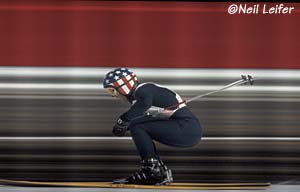
Neil: That was a photograph thatís in the book
of Billy Kidd skiing in a downhill race. The camera is a Rube Goldberg
made by Al Schneider. Basically what he created was a portable photo
finish camera. The film goes one way, the subject goes the other way and
instead of a shutter thereís a slit and the subject actually records
itself. I needed to know how fast Billy was going to go and
he said he could pick a spot for me on the hill where heíd be going 60
mph. At that point you want to figure out how to make the film go at the
same speed as the skier so I would get a real image. If the film is going
faster than the skier you get an elongated image, and if the film is going
slower than the skier you get a bulbous sort of squeezed image. Well I knew that the speed limit on this parkway was 60
mph and most people are going at the speed limit, and so I tested at the same
distance, with same lens and the same camera. Thereís a calibration on the
camera and I made notes about what I had done. When I had the setting
that gave me a round tire I knew that the camera was set for 60 mph.
Chris/Larry: And then after you calculated and you
practiced and you worked, you prayed that everything would come together
just right for you.
Neil: I wasnít really worried about my part. Once I knew the equipment was working properly Billy handled the
rest. Donít forget, this isn't like stopping action. I couldnít
miss because as the subject goes by it records itself. So all I needed was
Billy not to fall and to pass the camera at 60 mph, which he promised me
he would do. (laughs) So it was actually pretty easy, all things
considered. I remember even practiced in the winter in New York given the fact that batteries are different in the cold.
Chris/Larry: There are shots though that transpire
in front of you that you only have one chance at. Iím thinking of a
passage in the book where you are actually in competition with Frank
Sinatra at a fight. When youíre in a fast paced situation, like the fight
that weíre referring to, where you and Frank were both shooting it. You
clearly got the pivotal moment. You caught the instant, where he had
some nice overall shots. You both basically had the same opportunity but
you got the shot.
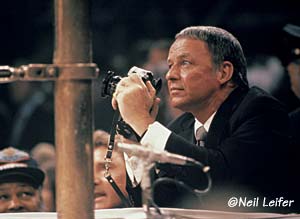
Neil: That isnít quite the way it happened.
This was the first Ali Fraser fight. Because the demand was so high
for credentials and ringside seats, they created a photo pool and Sports
Illustrated was given the pool assignment. I was one photographer and
Tony Triolo was the other. We were the only two pool photographers
shooting ringside. Obviously Life Magazine was going to do
a big piece on the fight in addition to Sports Illustrated, which was
our primary mission. Our pictures were going to both magazines and
both of us would have liked to get the Life Magazine cover. About a
half hour before the fight, an editor from Life Magazine came over and
whispered to me something like, listen, we need one
picture youíve got to be sure to get. Frank Sinatraís going to be
shooting over there in the corner. Make sure to get a picture of him
with his camera. And by the way donít forget to get a picture of
Norman Mailer who was seated in the press section. Now I knew Mailer had been hired by
Life to write the fight, obviously Sinatra didnít have a photo
credential but he certainly knew enough people that they squeezed him
in. And as soon as I was told that, I knew what a smart idea that was
to have Frank Sinatra, who was a serious amateur, shooting ringside.
The truth is that I never viewed him as competition because as soon as
they told me that Sinatra was shooting the fight, I knew the fix was
in that heíd get the cover. I had been asked to photograph
Sinatra, not for a gossip picture but for the publisherís note. They
used a picture of Norman Mailer and a picture of
Frank Sinatra ringside, camera at the ready. As soon as it happened I knew it wasnít going to be
a fair contest for who had the best cover picture. Sinatra got the cover of course,
and Itís OK,
nothing special. I think that if they were looking at the pictures without
knowing who Sinatra was he wouldnít have had a chance. They ran an ad in
the New York Times the day the magazine came out which said In big type ďThe FightĒ.
And then under that it said ďThe Writer - Norman MailerĒ, ďThe
Photographer - Frank SinatraĒ. Clearly theyíd prepared that ad before the
fight. So I never took the competition seriously. The fact is that Sinatra got a
beautiful picture inside because he tilted the camera and created sort of
a ring that was slightly slanted. In my case, if I had sat there playing around in the middle of
the fight they would have fired me because that could have been the moment
that the knockout occurred. The sad part of that fight was that when Joe
Fraser knocked Mohammed Ali down he knocked him down right in front of
Tony Triolo who got the SI cover and
I couldn't have been in a worse seat. So Iím proud of the fact that I got
any picture. I got a picture of Ali and his back with his arms up in the air
and the red tassels on his shoes flying but I didnít get either cover and I donít consider it one of my best days.
Chris/Larry: What are your favorite sports to
shoot? And what are the most difficult sports for you to photograph?
Neil: The most difficult sport for me to photograph was always
baseball, because nothing happens most of
the time. To make good pictures of baseball was always challenging to me.
I mean anyone can take a picture of a collision at home plate if thereís a play at the plate. Or a terrific double play with the shortstop
leaping over the sliding runner. But what do you do when nothing happens,
because so much of the game nothing happens. In football thereís action on
every single play. In Basketball every time you go to the basket thereís a
potential photograph. Baseball was always the most difficult for me to
make exciting pictures. When the action is exciting youíve got to make
sure youíre still awake. But my favorite without question was boxing.
Chris/Larry: And why is that?
Neil: Because you are so close to action. When the boxers are up against the ropes
right in front of your position, youíve actually got to lean back to get them in the
frame, even with a wide-angle lens. Sometimes youíve got to make sure not
to get stepped on. Secondly, thereís a wonderful history. Certainly the
great heavy weight fights of the past influenced my love of the sport. Iím
going back to Joe Louis, Rocky Marciano, Floyd Patterson and young
Cassious
Clay and then Muhammad Ali and George Foreman. Sugar Ray Robinson was
before my time. I photographed him at the end of his career. I just like
the history of boxing and I like the athletes and I like the people. I think
that with a few exceptions, by in large, boxers were the nicest people I
worked with in sports. And I think that most people that cover boxing will
tell you that.
Chris/Larry: I remember reading somewhere that
square was the perfect format to photograph boxing. It seems that overall
in your book a lot of pictures are shot with a square format. Were those
shot with a Hasselblad?
Neil: The square format was only convenient for use with strobes. In the early 1980ís television
barred strobe lights from boxing so by the time Ali was finished we werenít
allowed to use strobes anymore at fights. Iíve used 35mm at all the fights
since then including all the Sugar Ray Leonard and Mike Tyson fights. One
reason we used to use 2 ľ x 2 ľ was the format is wonderful. It
immediately takes away the decision-making whether to turn the camera
horizontal or vertical? The action is going so quick and it takes one
decision out of your hands. You can do that in editing rather
than when shooting. And, with the larger format with strobes, you
were using a slower speed higher quality film. The quality of those photographs
was
just phenomenal. But the main reason one used 2 ľ format in those days was
the synch speed with strobes. I started off with Rolliflexes and then I
moved to Hasselblads later on. The Rolliflex and the Hasselblad both synch
at a 1/500 of a second thereby getting rid of whatever ambient light would
be there so you didnít have a ghost image. Thatís the simple reason.
Chris/Larry: How do you feel about retouching
photographs, digitally or otherwise? Is that a legitimate way to enhance
the way pictures communicate a story?
Neil: It depends on what youíre presenting. If
youíre doing a shot for advertising, sure. Or retouching a scratch. News
photography should certainly not be retouched. When youíre presenting a
news picture itís supposed to be the way it was taken. And if youíre
enhancing things and digitizing things and moving things around, I find
thatís not journalism. I also think that in this book the pictures
should be presented as they were shot. But there are two scratches on my
Ali Liston picture on the cover of the book that have been removed. There
is a scratch in Listonís head and in his hair. And there is a scratch in
the ropes on the left side. Weíve had those taken out ages ago, so that I
have a duplicate transparency that I use for reproduction that doesnít
have those two scratches in it.
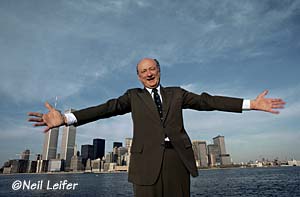
Thereís one picture in the book that something was
taken out of it and I was asked how I felt about it. There was a
seagull right over Ed Kochís arm in the picture of Koch. And you
couldnít tell what it was because it looked like a dirt spot.
The publisher came to me and asked if I would mind them taking it out? I looked at it and felt itís not cheating
because the picture youíre looking
at is exactly what I took. Itís the original Kodachrome transparency. But
there was this ugly spot that you couldnít tell
what it was so it was removed.
Chris/Larry: I wanted to touch a bit more on the
later shooting that you did when you were traveling the world and
photographing for Time Magazine and Life Magazine.
Neil: Don't forget I also did a good amount of traveling the world
in my early days with Sports Illustrated.
Chris/Larry: That too, certainly that. But I was
curious about a single quote you have in the book where you say that, ďyou
lose sight of fear when you look through a cameraĒ. Tell us about some of
the interesting situations youíve been in.
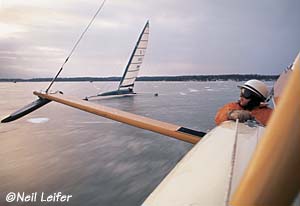
Neil: Iíll give you my best story. Thereís a picture in the
book of ice boating and you can see how one runner is
way off the ice. In the 60ís I went out to middle of Wisconsin to do the
ice boating story. Iíd go out every weekend to photograph a former Olympic
sailor named Bud Melges who was sort of my guide and made sure I got
everything I needed. They took me out about a half dozen weekends
in different boats to shoot the ice boating. I was positioned about eight inches off the ice, riding backwards
with no seatbelt. Iím kneeling in this little
cutout like a canoe and riding backwards looking at the skipper. When the wind was right and there were no
snowdrifts they can go as fast as 140 miles an hour. And it's not unusual
for one of the runner blades to be
four feet off the ice. In the dozen times I went out
the conditions were right about three or four times, the other times
we went about 80 miles and hour because there wasnít a really good wind.
But I did do a number of days at 140 miles and hour, loading cameras,
focusing, worrying about the horizon line. Iím not going to suggest that I was never concerned
because every once in a while you grab the side cause you thought the
boat was about to tip over. But most of the time I had so much to think about that I really wasnít afraid.
When I finished the essay the people that Iíd been shooting asked me if the magazine
wouldnít let me come out for a weekend and show them the pictures. They
were going to throw a party and teach me to sail an ice
boat. So I went back and asked my editor if I could bring out a tray of
slides. He said OK as long as I didnít give them any. So I put together a carousel of my selects, my best pictures,
and I flew out without any cameras just to have some fun. This was the
weekend Bud Melges was going to teach me to sail
a boat. So now I'm sitting in the seat you sail from. There was no wind
the weekend I sailed, and since it had snowed all night, there were
snowdrifts on the ice. I donít think we ever got the boat up over 40 or 50
miles and hour tops. Thatís a hell of a difference from 140 miles an hour.
Only now I was controlling the sail. I kept feeling these little pellets
of ice that sort of ting as they come back flying at you from the front
runner blade. I remembered cleaning them off my lens when I was sitting
next to the skipper so that I would get pictures from the skippers point
of view. All of a sudden now
Iím sailing the boat. These things are like bullets but it was nothing
more than an annoyance when I was shooting. Theyíre hitting me in my
cheeks and Iím getting frightened to death. Iíve never been so scared in
my life. And I was probably going 40 miles per hour instead of 140. So I
think the camera, just the idea that you put your mind in another place, not that it gets rid of the fear, but you donít have time to
think about how frightened you are if youíve got all these other things to
think about.
Chris/Larry: You photographed inmates in prison
for the story that was called Inmate Nation. You got some very dramatic
shots, particularly the overhead shots of the cells and such. Was there
any danger there?
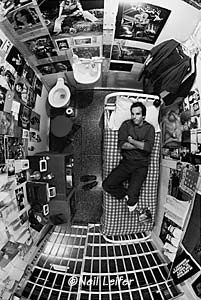
Neil: Quite honestly there was nothing to be afraid of there.
Inmates are the most litigious group of people in America and you cannot
run their pictures without releases. The lawyers at Time Magazine were
absolutely insistent that anybody that was going to be in the prison essay
had to sign a release and I had to spend a lot of time talking to them
before shooting. They wanted to know what I was doing and why I want to
take their pictures. Then hopefully I would take what looks like candid
spontaneous pictures. But there was really nothing to be afraid of. You
donít want to spend time in a prison debating the legal system with
inmates. I didnít want to get into their cases, which many of them wanted
to talk about and I would always explain to them that I was doing a photo
essay about how they lived, not debating the merits of the prison system.
Chris/Larry: Tell us about shooting wildlife. You
spent seven weeks in Kenya shooting. That sounds like quite a dream
assignment.
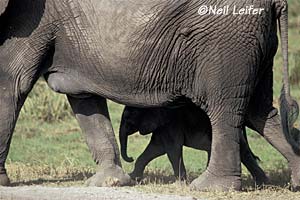
Neil: It was a dream assignment. I think it was the greatest
assignment imaginable. I love animals and it was a thrill to be able to do it the
right way. On the other hand, while seven weeks seem like a long time,
it really isn't nearly enough time. What
youíre competing with are the photographers like the National
Geographic people that spend 18 months in the Serengeti to get their
photo essays. Seven weeks is a very
limited amount of time. For example I saw only one leopard in seven weeks.
So what seems like a lot of time is not really for that type of
assignment. It was very challenging because itís basically hunting with a camera.
Chris/Larry: How long were the assignments
generally? You talk about going to Wisconsin for six weeks.
Neil: They range from five minutes with Ronald Reagan in the
oval office to seven weeks for my animal essay, to a full year of doing the Olympic essay. The
prisons essay was also shot over a 12 month period. The session
with the President of the United States in the oval office is often five
or ten minutes but has to look like youíve been there all day. So it
really varies completely. Another example like when youíre doing movie posters, youíve got people in the middle of doing something thatís a lot
more important than posing for the still photographer. Iíve done what they
call special shoots on movies, for the posters that go outside the theater,
and 20 minutes is a long time to get with Robert Redford or Sean Connery.
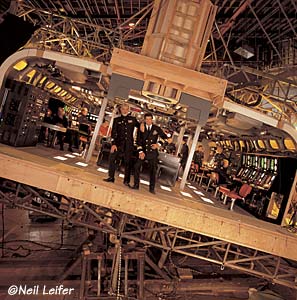
The picture thatís on the back cover of the book was
done for Life Magazine, not for the movie company, and it was done at
lunchtime on the Red October set. I have the whole crew of the
submarine including Sean Connery and Alec Baldwin there and I only had 15 minutes. That
was the entire shoot. The Red October set that I shot was not being
used that whole week. They were shooting in the missile bay, which was another set on another
sound stage. It took me two days to light it and figure out what I wanted and
to do my
test shots. When Alec Baldwin and Sean Connery came in I knew exactly
where I wanted them and it was just a matter of putting the real actors where the stand-ins had been.
Chris/Larry: Was there any one thing that you
worried about when going out on a shoot?
Neil: I always worried about getting the exposure right and getting the
picture in focus. Thatís really what I thought most of the time. I
worried about that all the time.
Chris/Larry: Jay Maisel told us exactly the same
thing.
Neil: It was true. You couldnít trust the meter in
the camera. You always had to hand meter and basically you learned from
experience that the best meter was in your head. And a test roll because I
genuinely worried. I was always shooting chrome. The latitude is very very
narrow in terms of getting it to look right in a magazine. And you had to
be nuts not to worry.
Chris/Larry: And thatís exactly what Maisel said.
Everybody worries about that. Which is one of the reasons heís absolutely
gone nuts over photographing with the Nikon D1 and working digitally
because you see immediately what you have.
Neil: I know, I read that in the piece that you
guys did with him.
Chris/Larry: And that really is. Thereís a
wonderful amount of feedback. Of course if youíre in the middle of
photographing a fight or something, where any blow can be the knock down.
Youíre not exactly reviewing your pictures to see if you have them. Never
the less, you can quickly test lighting and test the situation.
Neil: As for the digital stuff, for example. I'm a computer
illiterate. When I went to work
for Frank Deford, editor and chief of The National (the daily sports paper)
we were constantly on very tight deadlines. On the night of the Evander
Holyfield - Buster Douglas rematch our absolute deadline was 11:00 PM.
That was the last minute we could still get a picture to all of our
plants. Everything was being syndicated. But at 11:00 it had to be in.
The fight was supposed to start at 10:30 but theyíre never on time. I had
Ken Regan shooting digital. Weíre talking 10
years ago. I was sitting under the ring
with the guy that had the transmitter and the computer that would edit the
pictures. Ken was shooting digital. The fight began at seven minutes
to 11 and I think it was the second round that Holyfield knocked Buster
Douglas out. By about three minutes to 11 I was viewing three or
four frames of the KO on a screen underneath the ring. I transmitted the
best frame
to New York at 10:59 and it made page one of all the papers.
And that was the very beginning. I was talking to a photographer at the
Daily News yesterday, and theyíre 100% digital now. She hasnít shot a picture
that isnít digital. Thatís all she uses now at the newspaper. I saw digital coming years ago,
like I said, when we did this fight.
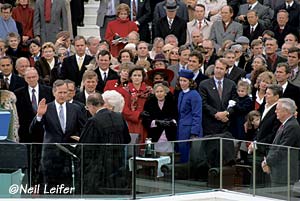
You saw the picture of George Bush being sworn in at his 1998 Inaugural?
Well, I was in the fourth position on the mail photo stand. It was AP, UPI and I
think that the Washington Post was next and then Time Magazine. There
were hundreds of newspapers waiting for the picture of the President
being sworn in. I think it was Bob Dougherty shooting with what might have been the
first digital camera I ever saw. He started shooting with the digital
camera when Bush raised his hand and said the first one or two words. He
took the disk out and dropped it to a guy that was right on the stand
below us. They were transmitting it around the world before Bushís hand
went down. Every newsroom used the AP picture, not the before UPI picture, which
shot on film, because the firstest is the bestest. UPI dropped the
roll of film, processed and printed wet in a little portable darkroom they
had underneath but they got clobbered.
Chris/Larry: I understand that now youíre selling
original prints of your work?
Neil: Yes, I have been since 1992.
Chris/Larry: How would someone go about buying one
of your pieces?
Neil: I now have a web site
www.NeilLeifer.com
and we sell prints ordered directly from it. I also have six galleries that represent my work.
They are in New York, Los Angeles, Washington Austin, Palm Beach and Santa
Fe.
Chris/Larry: Tell us about your new love, about
movie making.
Neil: Thereís an old adage about
being on a film set "Either
you fall asleep or fall in love". And I fell in love with the
process and would like to be a successful moviemaker. I went into into
still photography with big dreams. And Iíve been lucky enough for the most
part to have my dreams come true. Iíve had wonderful gallery shows of my
still photographs and
Iím thrilled with the book Iíve got out. Now Iíd love to have somebody
sitting in the back of the Ziegfield Theatre in Manhattan as excited about
one of my movies as they are about the book, or about one of my photo
exhibitions, that would be a thrill to experience.
Chris/Larry: Youíve directed two feature
length films so far, ďYesterdays HeroesĒ, with Ian
McShane and Suzanne Somers and ďTrading HeartsĒ with Raul
Julia and Beverly DiAngelo. Is it a real different way of working to be
making movies instead of doing things yourself?
Neil: It depends. As far as Iím concerned, a
good director is certainly responsible for the entire picture. You hire a
cinematographer, somebody whose vision is the same as yours, who lights
things the way you would light it. In theory, if you look at my Olympic
essay, the athletes around the world, or you look at any number of the
good things Iíve done photographically, Iím directing the photograph. Itís
the same thing. You have to work with people. You have to motivate people
to do their best for you in front of your lens as a photographer. And I
think making movies is just an extension of that. I learned a whole lot
about making movies from being on movie sets and the more I watched, the
more it seemed like a natural extension.
Chris/Larry: Do you see todayís technology making
the movie industry more open to new comers, or do you think the studio
system will continue to dominate as it is today?
Neil: Technology is a separate issue. The studio
system is the system that pays stars 20 million dollars a picture and
distributes films to 3,000 screens on any given weekend. Where as
independent films may open up on half a dozen screens and hope that they
catch fire and get great reviews. Theyíre both interesting areas to work
in. I would love to have somebody give me an 80 million dollar budget to
play with and see what I can do. But on the other hand, Iíd be just
as happy if somebody hired me to direct a film for a million and a half dollar
budget. Both the films I did were small budget films. I think theyíre both
good films but if they werenít, it would not be because we didnít have
enough money to make them well.
Chris/Larry: Do you have any upcoming projects,
anything that youíre currently working on?
Neil: I just produced a documentary for HBO Sports
called ďPicture PerfectĒ which aired the 21st of January. I
worked with another guy named Joe Levine who's a wonderful award-winning
producer. I learned so much. Itís a documentary of the iconic sports
pictures of our times. It was my idea, which I pitched to HBO. And ESPN
just did a documentary based on ďThe Best of LeiferĒ, so Iím learning
about documentaries. I have a documentary idea that
Iím trying to get going. George Plimpton and I want to do one together on
George's magnificent life. So thatís one that Iím playing with. Iíve
also got a feature film script based on a short film about two years ago called ďScouts
HonorĒ which Alec Baldwin and Bill Murray starred in. We went
to a number of festivals with it. The feature will be called ďSearching
for JordanĒ. And what it does is
combine all the things Iíve learned over the years. Obviously I
know a little bit about basketball and shooting sports. But I also spent a
year doing prisons in America. Itís a comedy about two basketball scouts
who are looking for the next Michael Jordan in the prisons in America.
Short timers, guys who are in, not on rape or murder charges, but guys who
go in at 17 and theyíre going to get out at 22 and have nothing to do but
spend eight hours a day playing basketball while they serve their time.
And nobodyís ever heard of them. Theyíre not scouted by the big scouts
obviously, they havenít come from the big universities. Our hero comes
up with the idea that there must be an entire NBA all star team
incarcerated in the prisons of America, and he is going to fine the best
of them. So thatís a project that I'm trying to get going. Ed Pressman, whoís
very successful producer has optioned the project. Itís a long way
from being made into a movie, but weíre getting closer.
Chris/Larry: Whatís the most difficult part about
making a movie?
Neil: The most difficult part is just dealing with
the characters that are Hollywood. Itís challenging and itís fun. The most
difficult part is getting someone to finance your film. Itís so simple,
itís about money. Somebody puts the money up and you can make a film,
period.
Chris/Larry: That would sure bring us a lot of
traffic to our web site (we all laugh). What about the actual distribution?
When you worked for Time Life, what you shot was seen by the world.
Neil: Iím absolutely crazy about my book. I would
do another book with Abbeville Press in seconds because they do such
beautiful books. But I have nothing to do with how they distribute and
market it. I think that if Mr. Paramount or Mr.
Warner Brothers wants to give me 30 million dollars to make a movie, they
can distribute it any way they want. Would I like to see them sell it
properly? Sure. But unless youíre Steven Spielberg or Tom Hanks, you can
get things not only made the way they want it made, but also the
distribution they want. But thatís just dreaming at another level. I would
love to have my book priced lower and available in more book stores with a larger print
run. But thatís what they pay the publisher for.
Chris/Larry: Do you have any parting words for
photographers, any advice you would give to people who are starting out in
photography now?
Neil: Not really, because itís such a different business
today. I do know itís a lot harder today than it was when I started. I
say that because itís become such a popular profession. Itís sort of
become a glamour game in a sense. When I began there were far fewer
photographers and far more places to get published. Today there are more
photographers, far more photographers, coming out of schools with degrees.
Good photographers and far fewer places to work and therefore I think itís
a much tougher business to crack. But having said that, thereís always
going to be another Richard Avadon. Thereíll be another
Annie Leibowitz. Thereíll be another Walter Iooss.
Who knows, there might be another Neil Leifer, you know. I would never
discourage any young person from going into the field but I just think
itís a much tougher nut to crack. A much, much tougher business than it
used to be.
Note from the authors
After we finished the interview, Neil was still talkative so we discussed
the influence he had on my own sports career
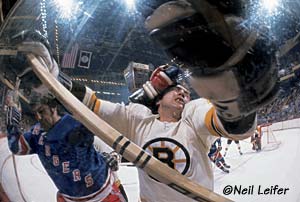
Larry: When we were asking you about whether
there were any pictures that influenced you. I just wanted to tell you
that one of your pictures, with the 17mm lens from the corner of the
hockey game between the Bruins and the Rangers was an influence on me.
I went out and bought a 17mm Pentax lens and had it converted to a
Nikon mount by Marty Forscher. And when I was the staff photographer for the Nets, I used it to
experiment in shooting basketball with it. I was definitely influenced by
your career.
Neil: I think thatís the way any
photographer learns. Looking at good pictures and trying to figure out
what the
photographer is doing and how theyíre doing it, and hopefully bringing
your own ideas and your own approach to it and I think that having heroes
is great. I still remember looking at John Zimmermanís pictures. They used
to blow me away, I was such a big fan and Hy Peskinís action pictures. I
always wanted to take pictures as good as Hyís.
Larry: Your boxing pictures are probably
considered the best in the world. I used to look at them and say I wish I
could do that.
Neil: I was there with the greatest athlete
of our time, donít forget. Having Ali as a subject didn't hurt believe
me. No one would remember if
you happen to take the greatest picture of all times of Larry Holmes,
heavy weight champion for a long time, who cares? Who cares? I must have
ten Larry Holmes fights and I canít even remember the last request from
anybody to even use a picture. I mean, when Larry Holmes dies, someone
will call and say, do you have a picture of Larry Holmes? So you know,
nobody cares. And if you have beautiful pictures of Jerry Quary, Floyd
Patterson, nobody calls for them, either. But with Ali, the phone never
stops ringing.
Chris/Larry: Thatís another generation away now
also.
Neil: With sports photography, it sure make a difference if you happen to have
great pictures of an icon, like Michael Jordan, or Ali who's pictures are looked at all
the time. Pictures of them are
sought after all the time.


